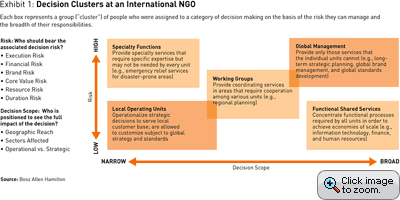The Best Decisions Are Clustered
By assigning groups of individuals to categories of decisions, organizations can maintain coherence in the face of uncertainty.
Decision making is the lifeblood of any productive organization: The ability of an organization to execute its strategies effectively is determined by who makes which decisions, and how they are made. But most organizations are unnecessarily burdened by widespread breakdowns in the decision-making process.
Senior managers know the symptoms well. Their inboxes overflow with e-mails from subordinates escalating a conflict that should have been resolved weeks earlier, two management layers down. Their calendars are crammed with meetings at which many issues are discussed but no decisions are made, so the issues are taken up yet again more urgently the following month. Or after the rare meeting in which a decision is made, executives are lobbied in the halls and over lunch to rethink the agreement all over again.
In most cases, decision making fails because decision rights are unclear. Decision rights are the rules — either consciously designed or tacit and informal — that establish individual responsibilities. When these rules are ambiguous or contradictory, then people don’t know where their own authority ends and another’s begins. Such lack of clarity about who does what in an organization leads to missed opportunities, duplication of effort, overlap or erosion of accountability, and enormous amounts of time and resources wasted.
In a startling illustration of this organizational dysfunction, we asked 13 managers at a manufacturing unit in a biotechnology company to indicate which individual was currently assigned the decision to finalize the group’s monthly production sequence. They identified no fewer than six people as being “in charge.” Upon seeing the results of this simple exercise, the managers immediately understood why they found themselves trapped in a seemingly endless cycle of repetitive daily meetings: The same decision was being made, unmade, and remade through six different processes, led by different managers, and the processes and managers were connected to one another only loosely.
To clarify decision rights, many managers use what we call the “decision inventory” method. Simply put, this approach involves making a list of the specific decisions that routinely must be made in an organization and defining the roles of particular individuals or groups with respect to each decision. Because decision inventories force companies to take stock of the everyday decisions that have quietly multiplied throughout the organization — something that few companies do with any regularity — they can be powerful tools for identifying and resolving overlaps and gaps in the allocation of decision rights. Indeed, the use of these frameworks often provides a dramatic one-time improvement in an organization’s decision-making process.
But such inventories have significant limitations. In particular, decision inventories are static, whereas decision-making environments change constantly. Organizations routinely face situations that arise unexpectedly: Will we invest in a new technology? How should we respond to a natural disaster that disrupts our supply chain? Since no one can predict all of the possible combinations of decisions the company may face, it’s simply not possible to preassign decision roles to cover all possible scenarios. Eventually, even the most comprehensive decision inventory will encounter a situation that wasn’t imagined.
To allow decision makers to maintain coherence in the face of uncertainty, organizational leaders can frame their decisions as clusters. Rather than treating each decision as a separate entity requiring a specific assignment, this approach helps companies understand why certain calls should be made in particular locations or by particular groups of individuals. The design of these decision clusters is determined by the scope of the organization affected by the decisions and the degree of associated risk.
For example, consider the way a multinational manufacturing firm decides whether to outsource maintenance services for its network of plant facilities. If no supplier can provide global maintenance services and offer significantly better terms for a firmwide contract, then there is little harm, in the form of lost discounts, in making the decision at the local level — in a “low-risk, narrow scope” cluster. Each plant could decide which firm to hire.
But if a supplier has the wherewithal to provide maintenance services to multiple, geographically dispersed locations and offers a significant discount for doing so, then the risks associated with the decision are escalated: The discount would be forfeited if each plant chose its own maintenance supplier.
Furthermore, since a multiplant contract would affect more than one plant, the scope of the decision has also increased. Consequently, a “high-risk, broad scope” cluster — at the level of territory, country, or even region — would be the best option for making the decision.
We recently applied the decision cluster approach to a global nongovernmental organization. (See Exhibit 1.) We developed decision clusters based in part on who had the right information and incentives to make each type of decision well. For example, a decision such as the selection of future project sites within a country would affect only a single office, and was relatively low risk and narrow in scope. This category of decision could be made at the local operating unit level, since there was little in the way of organizational perspective or risk protection to be gained by involving global headquarters.
But other decisions, such as an investment in a organization-wide project management information system, would alter activities in virtually every location. These decisions required broader oversight that only global management could provide.
The cluster approach ensured that decisions were assigned to people who had appropriate information and perspective. By articulating the logic behind the decision-making clout of each cluster of people, this method manages the changing dynamics of the business environment much more effectively than a decision inventory alone.![]()
Matt Calderone (calderone_matthew@bah.com) is a senior associate with Booz Allen Hamilton in New York. He specializes in organizational transformation, people issues, and change management.
Karla Martin (martin_karla@bah.com) is a principal with Booz Allen Hamilton in San Francisco. Her work focuses on the role of organization in driving growth and reducing complexity, and on change management.
Decio Mendes (mendes_decio@bah.com) is a senior associate with Booz Allen Hamilton in New York. He works with clients to improve organizational effectiveness and operations efficiency.
Also contributing to this article were Booz Allen Hamilton Senior Associate Chris Click, Senior Associate Elizabeth Powers, and Associate Michelle Vandebraak.



